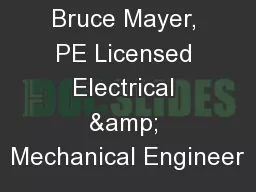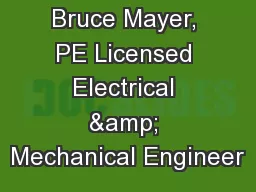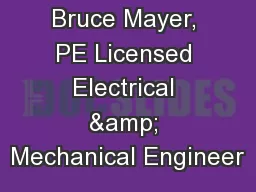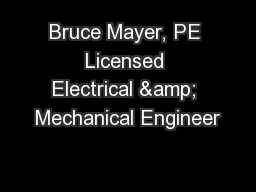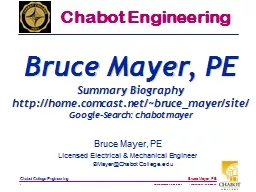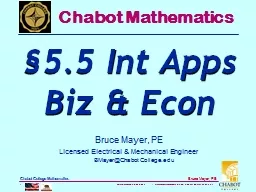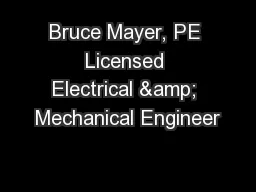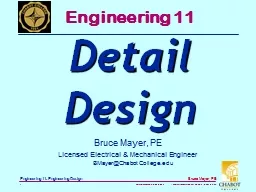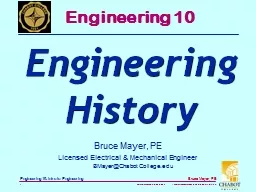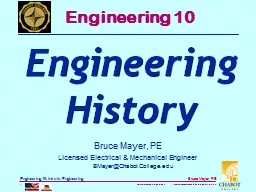PPT-Bruce Mayer, PE Licensed Electrical & Mechanical Engineer
Author : jane-oiler | Published Date : 2019-06-29
BMayerChabotCollegeedu Engineering 36 Chp 5 Equivalent Loads Introduction Equivalent Loads Any System Of Forces amp Moments Acting On A Rigid Body Can Be Replaced
Presentation Embed Code
Download Presentation
Download Presentation The PPT/PDF document "Bruce Mayer, PE Licensed Electrical &..." is the property of its rightful owner. Permission is granted to download and print the materials on this website for personal, non-commercial use only, and to display it on your personal computer provided you do not modify the materials and that you retain all copyright notices contained in the materials. By downloading content from our website, you accept the terms of this agreement.
Bruce Mayer, PE Licensed Electrical & Mechanical Engineer: Transcript
BMayerChabotCollegeedu Engineering 36 Chp 5 Equivalent Loads Introduction Equivalent Loads Any System Of Forces amp Moments Acting On A Rigid Body Can Be Replaced By An Equivalent System Consisting of these Intensities acting at . Licensed Electrical & Mechanical Engineer. BMayer@ChabotCollege.edu. Engineering 10. Engineering. Disciplines. ¿. Class Question on CE ?. What types of things might a CIVIL Engineer Design?. . BMayer@ChabotCollege.edu. Engineering 43. Chp. . 14-2. Op Amp Circuits. RC OpAmp Circuits. Introduce Two Very Important Practical Circuits Based On Operational Amplifiers. Recall the OpAmp. The “Ideal” Model That we Use. BMayer@ChabotCollege.edu. Engineering 36. Chp. . 7:. Flex Cables. Recall Chp10 Introduction. Examine in Detail Two Important Types Of Engineering Structures:. BEAMS - usually long, straight, . prismatic members designed to support loads applied at various points along . BMayer@ChabotCollege.edu. Engr/Math/Physics 25. Chp3 MATLAB. Functions: Part4. Learning Goals. Understand the difference . Built-In. and . User-Defined. MATLAB . Functions. Write User Defined Functions. BMayer@ChabotCollege.edu. Engineering 11. Engineering. Design. OutLine. . . Engineering Design. What is engineering design, really? . Function to form. Design process. Phases of design. Product Realization/Development Process . BMayer@ChabotCollege.edu. Chabot Engineering. Bruce Mayer, PE. Summary Biography . http://home.comcast.net/~bruce_mayer/site/. Google-Search. : . chabot. . mayer. EDUCATION. MS Electrical Engineering, . BMayer@ChabotCollege.edu. Chabot Mathematics. §5.5 . Int. Apps. Biz & Econ. Review §. Any QUESTIONS About. §5.4 → Applying the Definite Integral. Any QUESTIONS About . HomeWork. §5.4 → HW-25. BMayer@SBCGlobal.net. Engineering. New-Grad Employment at Stanford, . CAL, . MIT, . CalPoly. :. What’s Important. to Employers. Recent Chabot Engineering . Interns. Joshua . Przepioski. → NASA-Ames ACCEDP. BMayer@ChabotCollege.edu. Engineering 11. Detail. Design. OutLine . Detail Design. Flow of design information . Responsibility for “details”. Graphic communication. Written communication. Oral presentations. BMayer@ChabotCollege.edu. Engineering 10. Engineering. History. BackGround. The Earliest “Technical Drawings”, or “BluePrints”, Date Back to About 4000 B.C. With the . Fortress Plans of . the Chaldean . BMayer@ChabotCollege.edu. Engineering 10. Engineering. History. American Innovation. American Inventors/Engineers. Samuel Morse . . TeleGraph. Robert Fulton . SteamBoat. Eli Whitney Cotton Gin. BMayer@ChabotCollege.edu. Chabot Engineering. Degrees, PEs, and. System Engineering. Outline. Speaker Bio. Which Degree; BS, MS, PhD, PE?. Systems Engineering. What is it?. The Defining Attributes. How it Differs From CE, . BMayer@ChabotCollege.edu. Engineering 10. HomeWork. Assignment:. Engineering Degree. Course-Planning. Assignment Importance. Most IMPORTANT ENGR10 . Topics. Engineering Ethics. How to Earn the . BSEngineering. BMayer@ChabotCollege.edu. Chabot Mathematics. §10.3 Series:. Power & Taylor. Review §. Any QUESTIONS About. §10.2 Convergence Tests. Any QUESTIONS About . HomeWork. §10.2 → HW-18. 10.2. §10.3 Learning Goals.
Download Document
Here is the link to download the presentation.
"Bruce Mayer, PE Licensed Electrical & Mechanical Engineer"The content belongs to its owner. You may download and print it for personal use, without modification, and keep all copyright notices. By downloading, you agree to these terms.
Related Documents


